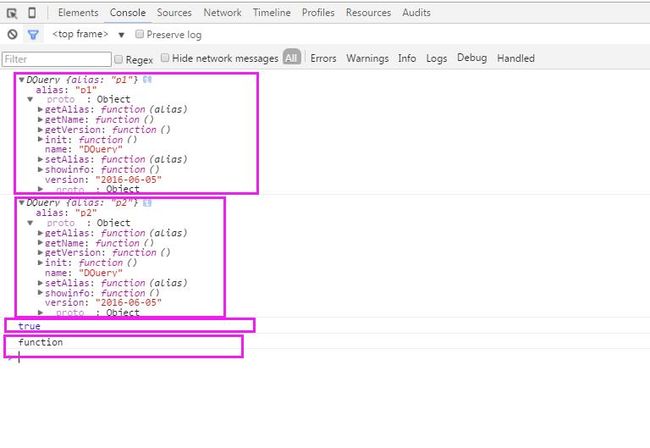开发自己的JQuery框架
通过json对象实现封装
这是最简单的一种封装方式,如下:
<script type="text/javascript"> /** *自执行的匿名函数,可以实现链式调用 **/ (function(w){ var DQuery={ 'name':'DQuery', 'version':'2016-06-05', 'getVersion':function(){ console.log(this.version); return this; }, getName:function(){ console.log(this.name); return this; }, showinfo:function(){ this.getVersion(); this.getName(); return this; } }; window.DQuery=$$=DQuery; //让外边可以调用 }(window)); </script>优点,简单,很容易阅读。
缺点:DQuery是一个对象,而不是一个构造函数,当输出DQuery的时候,里面包含的所有信息都暴露了(如下图)。其次,没法对其进行相应的定制,以生成不同的对象,满足不同情况下的使用。

通过构造函数实现封装
版本一
这个版本是大家首先都会想到的版本,程序如下:
(function(w){
var DQuery=function(){
this.alias=null;
}
DQuery.prototype ={
'name':'DQuery',
'version':'2016-06-05',
'setAlias':function(alias){
this.alias=alias;
return this;
},
'getAlias':function(alias){
console.log(this.alias);
return this;
},
'getVersion':function(){
console.log(this.version);
return this;
},
getName:function(){
console.log(this.name);
return this;
},
showinfo:function(){
this.getVersion();
this.getName();
return this;
}
}
window.DQuery=$$=DQuery; //让外边可以调用
}(window));调用代码如下
var p1= new DQuery();
p1.alias='p1'
var p2= new $$();
p2.alias='p2'
console.log(p1);
console.log(p2);
console.log(p1.showinfo==p2.showinfo);
console.log(typeof(DQuery));效果如下

优点:通过输出可以看出,首先DQuery是一个构造函数,便于我们根据相应的参数生成不同的对象。其次,在DQuery的prototype 中定义的变量和函数,是所有对象共有的,相当于是静态的。
缺点:每次创建一个对象都得去new一个DQuery难免有点麻烦。其次,还是有点暴露的。
版本二
针对版本一中的每次创建一个对象都得new一个,可能我们首先想到的是将其改为如下:
var DQuery=function(){
this.alias=null;
return new DQuery();
}这样,从代码上看是解决了存在的问题,但是又迎来了一个新的问题。即因为在DQuery创建起自身的对象,相当于递归调用,出现死循环的问题。

版本三
针对版本一和版本二中的问题,可以做如下改进
(function(w){
var DQuery=function(alias){
this.alias=alias;
return new DQuery.prototype.init();
}
DQuery.prototype ={
'name':'DQuery',
'version':'2016-06-05',
'init':function(){
},
'setAlias':function(alias){
this.alias=alias;
return this;
},
'getAlias':function(alias){
return this;
},
'getVersion':function(){
return this.version;
},
getName:function(){
return this.name;
},
showinfo:function(){
return this.name+':'+this.version;
}
}
window.DQuery=$$=DQuery; //让外边可以调用
}(window));
console.log(typeof($$));//$$是一个构造函数
console.log(typeof($$()));//$$()返回一个对象
console.log(typeof(new $$()));//new $$()返回一个对象
var p1=$$('id1');
var p2=new $$('id2');优点:解决了版本一和版本二中存在的问题。
缺点:无法调用类中(构造函数中)的属性和方法。
版本四
由new创建的对象,对象中的作用域是函数的作用域,其prototype也是构造函数的prototype(具体可以参考补充内容),那么,既然我们使用了new DQuery.prototype.init();,返回对象的prototype等于init函数的prototype。但是我们希望其指向DQuery函数的prototype。此时,有两种做法:
方案一:我们在init方法中,返回指向DQuery对象的this,但是这个在该条件下很难做的,因为我确定,用户是通过new DQuery来创建对象还是直接调DQuery()来创建对象
方案二:我们可以让init.prototype=DQuery.prototype,这样虽然是用init构造函数创建的对象,但是对象的prototype和DQuery的prototype相同。
于是将版本三改进后,代码如下如下:
(function(w){
var DQuery=function(alias){
this.alias=alias;
return new DQuery.prototype.init();
}
DQuery.prototype ={
'self':this,
'name':'DQuery',
'version':'2016-06-05',
'init':function(){
},
'setAlias':function(alias){
this.alias=alias;
return this;
},
'getAlias':function(alias){
return this;
},
'getVersion':function(){
return this.version;
},
getName:function(){
return this.name;
},
showinfo:function(){
return this.name+':'+this.version;
}
}
DQuery.prototype.init.prototype=DQuery.prototype;
window.DQuery=$$=DQuery; //让外边可以调用
}(window));
console.log(typeof($$));//$$是一个构造函数
console.log(typeof($$()));//$$()返回一个对象
console.log(typeof(new $$()));//new $$()返回一个对象
var p1=new DQuery();
console.log(p1);
console.log(p1 instanceof DQuery); //true

可以发现,此时已经有了完全符合我们的要求了,也解决了上面出现的问题。
版本五
开始以为版本4是没有什么问题,最后发现原来版本4还是有个小问题,即返回的对象,没法访问DQuery构造函数定义的属性。针对这个问题,我们可以通过call或者apply来解决。当然,其实也没必要,因为我们,直接可以讲一些属性定义在init方法中,何必定义在DQuery,然后给自己找麻烦呢。
****后续版本会继续添加*************
总结
(function(w){
var DQuery=function(){
return new DQuery.prototype.init();
}
DQuery.prototype ={
//定义一些静态变量
'self':this,
'name':'DQuery',
'version':'2016-06-05',
// 构造函数方法
'init':function(){
//定义一些变量属性
},
//定义一些方法
'setAlias':function(alias){
this.alias=alias;
return this;
}
}
DQuery.prototype.init.prototype=DQuery.prototype;
window.DQuery=$$=DQuery; //让外边可以调用
}(window));补充
构造函数的返回值对new一个对象的影响
首先我们来总结一下new一个对象的过程。比如使用Student构造函数创建对象var s1=new Student(),过程可以归纳如下:首先创建一个新对象,其次将构造函数的作用域赋给新对象(因此this指向这个新对象,且Student.prototype赋给该对象的prototype),然后再将该对象赋值给s1。
构造函数中没有指定返回值
该情况下,默认会返回新对象实例。
构造函数中存在指定返回值
1.返回值为基本数据类型的话,仍然会返回新对象实例。
2..返回值为对象的话,被返回的对象就成了指定的对象值。在这种情况下,this值所引用的对象就被丢弃了。
3.返回function的话,new不会返回一个对象,而会返回该function。
//无返回值
function Student1(){
this.name='dqs';
}
var p1=new Student1();
console.log(typeof(p1));//object
console.log('name' in p1 ); //true
console.log(p1 instanceof Student1 ); //true
//返回function
function Student2(){
this.name='dqs';
return function(){};
}
var p2=new Student2();
console.log(typeof(p2));//function
console.log(p2 instanceof Student2 ); //false
//返回基本类型
//返回基本类型
function Student3(){
this.name='dqs';
return 'nihao';
}
var p3=new Student3();
console.log(typeof(p3));//object
console.log('name' in p3 ); //true
console.log(p3 instanceof Student3 ); //true
//返回对象类型
function Student4(){
this.name='dqs';
return {'location':'hsd'};
}
var p4=new Student4();
console.log(typeof(p4));//object
console.log('name' in p4 ); //false
console.log(p3 instanceof Student4 ); //false欢迎访问DQS博客
博文地址:http://blog.csdn.net/hsd2012/article/details/51675074
